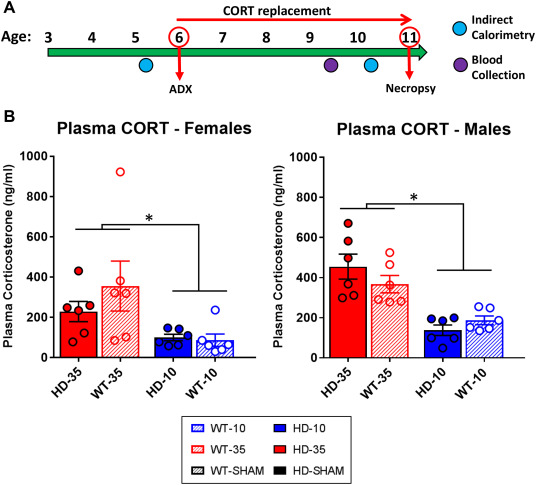当前位置:
X-MOL 学术
›
Neurobiol. Dis.
›
论文详情
Our official English website, www.x-mol.net, welcomes your
feedback! (Note: you will need to create a separate account there.)
Normalizing glucocorticoid levels attenuates metabolic and neuropathological symptoms in the R6/2 mouse model of huntington's disease.
Neurobiology of Disease ( IF 5.1 ) Pub Date : 2018-10-05 , DOI: 10.1016/j.nbd.2018.09.025
Brett D Dufour 1 , Jodi L McBride 1
Neurobiology of Disease ( IF 5.1 ) Pub Date : 2018-10-05 , DOI: 10.1016/j.nbd.2018.09.025
Brett D Dufour 1 , Jodi L McBride 1
Affiliation

|
Huntington's disease (HD) is a fatal genetic neurological disorder caused by a mutation in the human Huntingtin (HTT) gene. This mutation confers a toxic gain of function of the encoded mutant huntingtin (mHTT) protein, leading to widespread neuropathology including the formation of mHTT-positive inclusion bodies, gene dysregulation, reduced levels of adult dentate gyrus neurogenesis and neuron loss throughout many regions of the brain. Additionally, because HTT is ubiquitously expressed, several peripheral tissues are also affected. HD patients suffer from progressive motor, cognitive, psychiatric, and metabolic symptoms, including weight loss and skeletal muscle wasting. HD patients also show neuroendocrine changes including a robust, significant elevation in circulating levels of the glucocorticoid, cortisol. Previously, we confirmed that the R6/2 mouse model of HD exhibits elevated corticosterone (the rodent homolog of cortisol) levels and demonstrated that experimentally elevated corticosterone exacerbates R6/2 HD symptomology, resulting in severe and rapid weight loss and a shorter latency to death. Given that efficacious therapeutics are lacking for HD, here we investigated whether normalizing glucocorticoid levels could serve as a viable therapeutic approach for this disease. We tested the hypothesis that normalizing glucocorticoids to wild-type levels would ameliorate HD symptomology. Wild-type (WT) and transgenic R6/2 mice were allocated to three treatment groups: 1) adrenalectomy with normalized, WT-level corticosterone replacement (10 μg/ml), 2) adrenalectomy with high HD-level corticosterone replacement (35 μg/ml), or 3) sham surgery with no corticosterone replacement. Normalizing corticosterone to WT levels led to an improvement in metabolic rate in male R6/2 mice, as indicated by indirect calorimetry, including a reduction in oxygen consumption and normalization of respiratory exchange ratio values (p < .05 for both). Normalizing corticosterone also ameliorated brain atrophy in female R6/2 mice and skeletal muscle wasting in both male and female R6/2 mice (p < .05 for all). Female R6/2 mice given WT-level corticosterone replacement also showed a reduction in HD neuropathological markers, including a reduction in mHTT inclusion burden in the striatum, cortex, and hippocampus (p < .05 for all). This data illustrates that ameliorating glucocorticoid dysregulation leads to a significant improvement in HD symptomology in the R6/2 mouse model and suggests that cortisol-reducing therapeutics may be of value in improving HD patient quality of life.
中文翻译:

在亨廷顿氏病的R6 / 2小鼠模型中,使糖皮质激素水平正常化可减弱新陈代谢和神经病理学症状。
亨廷顿舞蹈病(HD)是由人类Huntingtin(HTT)基因突变引起的致命遗传神经系统疾病。该突变赋予编码的突变亨廷顿蛋白(mHTT)功能毒性增益,从而导致广泛的神经病理学,包括mHTT阳性包涵体的形成,基因失调,成年齿状回神经生成水平降低以及整个神经节区域神经元丢失。脑。此外,由于HTT无处不在,因此也影响了一些周围组织。HD患者患有进行性运动,认知,精神病和新陈代谢症状,包括体重减轻和骨骼肌消瘦。HD患者还表现出神经内分泌变化,包括糖皮质激素,皮质醇的循环水平显着升高。之前,我们证实HD的R6 / 2小鼠模型表现出升高的皮质酮(皮质醇的啮齿动物同系物)水平,并证明实验性升高的皮质酮加剧R6 / 2 HD症状,导致严重且快速的体重减轻和较短的死亡潜伏期。考虑到HD缺乏有效的治疗方法,在这里我们研究了使糖皮质激素水平正常化是否可以作为该疾病的可行治疗方法。我们检验了将糖皮质激素标准化至野生型水平可改善HD症状的假设。将野生型(WT)和转基因R6 / 2小鼠分为三个治疗组:1)进行常规WT级皮质酮替代(10μg/ ml)的肾上腺切除术,2)进行高HD级皮质酮替代(35μg)的肾上腺切除术/ ml),或3)不进行皮质酮替代的假手术。如间接量热法所示,将皮质酮标准化至WT水平可导致雄性R6 / 2小鼠的代谢率提高,包括氧气消耗减少和呼吸交换率值正常化(两者均p <.05)。皮质酮的正常化也改善了雌性R6 / 2小鼠的脑萎缩以及雄性和雌性R6 / 2小鼠的骨骼肌消瘦(所有p均<0.05)。雌性R6 / 2小鼠接受WT级皮质酮替代治疗后,HD神经病理学指标也有所降低,包括纹状体,皮层和海马体中mHTT包含量的降低(所有p均<0.05)。
更新日期:2018-10-05
中文翻译:

在亨廷顿氏病的R6 / 2小鼠模型中,使糖皮质激素水平正常化可减弱新陈代谢和神经病理学症状。
亨廷顿舞蹈病(HD)是由人类Huntingtin(HTT)基因突变引起的致命遗传神经系统疾病。该突变赋予编码的突变亨廷顿蛋白(mHTT)功能毒性增益,从而导致广泛的神经病理学,包括mHTT阳性包涵体的形成,基因失调,成年齿状回神经生成水平降低以及整个神经节区域神经元丢失。脑。此外,由于HTT无处不在,因此也影响了一些周围组织。HD患者患有进行性运动,认知,精神病和新陈代谢症状,包括体重减轻和骨骼肌消瘦。HD患者还表现出神经内分泌变化,包括糖皮质激素,皮质醇的循环水平显着升高。之前,我们证实HD的R6 / 2小鼠模型表现出升高的皮质酮(皮质醇的啮齿动物同系物)水平,并证明实验性升高的皮质酮加剧R6 / 2 HD症状,导致严重且快速的体重减轻和较短的死亡潜伏期。考虑到HD缺乏有效的治疗方法,在这里我们研究了使糖皮质激素水平正常化是否可以作为该疾病的可行治疗方法。我们检验了将糖皮质激素标准化至野生型水平可改善HD症状的假设。将野生型(WT)和转基因R6 / 2小鼠分为三个治疗组:1)进行常规WT级皮质酮替代(10μg/ ml)的肾上腺切除术,2)进行高HD级皮质酮替代(35μg)的肾上腺切除术/ ml),或3)不进行皮质酮替代的假手术。如间接量热法所示,将皮质酮标准化至WT水平可导致雄性R6 / 2小鼠的代谢率提高,包括氧气消耗减少和呼吸交换率值正常化(两者均p <.05)。皮质酮的正常化也改善了雌性R6 / 2小鼠的脑萎缩以及雄性和雌性R6 / 2小鼠的骨骼肌消瘦(所有p均<0.05)。雌性R6 / 2小鼠接受WT级皮质酮替代治疗后,HD神经病理学指标也有所降低,包括纹状体,皮层和海马体中mHTT包含量的降低(所有p均<0.05)。

































 京公网安备 11010802027423号
京公网安备 11010802027423号